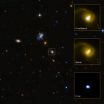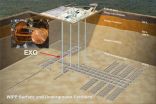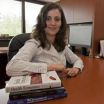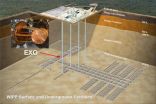(Press-News.org) Astronomers have found strong evidence that a massive black hole is being ejected from its host galaxy at a speed of several million miles per hour. New observations from NASA's Chandra X-ray Observatory suggest that the black hole collided and merged with another black hole and received a powerful recoil kick from gravitational wave radiation.
"It's hard to believe that a supermassive black hole weighing millions of times the mass of the sun could be moved at all, let alone kicked out of a galaxy at enormous speed," said Francesca Civano of the Harvard-Smithsonian Center for Astrophysics (CfA), who led the new study. "But these new data support the idea that gravitational waves -- ripples in the fabric of space first predicted by Albert Einstein but never detected directly -- can exert an extremely powerful force."
Although the ejection of a supermassive black hole from a galaxy by recoil because more gravitational waves are being emitted in one direction than another is likely to be rare, it nevertheless could mean that there are many giant black holes roaming undetected out in the vast spaces between galaxies.
"These black holes would be invisible to us," said co-author Laura Blecha, also of CfA, "because they have consumed all of the gas surrounding them after being thrown out of their home galaxy."
Civano and her group have been studying a system known as CID-42, located in the middle of a galaxy about 4 billion light years away. They had previously spotted two distinct, compact sources of optical light in CID-42, using NASA's Hubble Space Telescope.
More optical data from the ground-based Magellan and Very Large Telescopes in Chile supplied a spectrum (that is, the distribution of optical light with energy) that suggested the two sources in CID-42 are moving apart at a speed of at least 3 million miles per hour.
Previous Chandra observations detected a bright X-ray source likely caused by super-heated material around one or more supermassive black holes. However, they could not distinguish whether the X-rays came from one or both of the optical sources because Chandra was not pointed directly at CID-42, giving an X-ray source that was less sharp than usual.
"The previous data told us that there was something special going on, but we couldn't tell if there were two black holes or just one," said another co-author Martin Elvis, also of CfA. "We needed new X-ray data to separate the sources."
When Chandra's sharp High Resolution Camera was pointed directly at CID-42, the resulting data showed that X-rays were coming only from one of the sources. The team thinks that when two galaxies collided, the supermassive black holes in the center of each galaxy also collided. The two black holes then merged to form a single black hole that recoiled from gravitational waves produced by the collision, which gave the newly merged black hole a sufficiently large kick for it to eventually escape from the galaxy. The other optical source is thought to be the bright star cluster that was left behind. This picture is consistent with recent computer simulations of merging black holes, which show that merged black holes can receive powerful kicks from the emission of gravitational waves.
There are two other possible explanations for what is happening in CID-42. One would involve an encounter between three supermassive black holes, resulting in the lightest one being ejected. Another idea is that CID-42 contains two supermassive black holes spiraling toward one another, rather than one moving quickly away.
Both of these alternate explanations would require at least one of the supermassive black holes to be very obscured, since only one bright X-ray source is observed. Thus the Chandra data support the idea of a black hole recoiling because of gravitational waves.
The source is located in the Cosmic Evolution Survey (COSMOS) field, a large, multi-wavelength survey.
INFORMATION:
The other co-authors are Giorgio Lanzuisi (CfA), Thomas Aldcroft (CfA), Markos Trichas (CfA), Angela Bongiorno (Max-Planck Institute for Astrophysics (MPIA), Garching, Germany), Marcella Brusa (MPIA), Andrea Comastri (National Institute for Astrophysics (INAF), Bologna, Italy), Avi Loeb (CfA), Mara Salvato (MPIA), Antonella Fruscione (CfA), Anton Koekemoer (Space Telescope Science Institute, Baltimore, MD), Stefanie Komossa (Max-Planck Institute for Plasma Physics, Garching, Germany), Roberto Gilli (INAF, Bologna, Italy), Vincenzo Mainieri (XMM-Newton Science Operations Centre, ESA, Madrid, Spain), Enrico Piconcelli (University of Bologna, Bologna, Italy), and Cristian Vignali (Max-Planck Institute for Radio Astronomy, Bonn, Germany).
These results will appear in the June 10 issue of The Astrophysical Journal.
NASA's Marshall Space Flight Center in Huntsville, Ala., manages the Chandra Program for the agency's Science Mission Directorate in Washington. The Smithsonian Astrophysical Observatory in Cambridge, Mass., controls Chandra's science and flight operations.
Giant black hole kicked out of home galaxy
2012-06-05
ELSE PRESS RELEASES FROM THIS DATE:
High blood caffeine levels in older adults linked to avoidance of Alzheimer's disease
2012-06-05
Tampa, FL (June 4, 2012) Those cups of coffee that you drink every day to keep alert appear to have an extra perk – especially if you're an older adult. A recent study monitoring the memory and thinking processes of people older than 65 found that all those with higher blood caffeine levels avoided the onset of Alzheimer's disease in the two-to-four years of study follow-up. Moreover, coffee appeared to be the major or only source of caffeine for these individuals.
Researchers from the University of South Florida (www.usf.edu) and the University of Miami (www.miami.edu)say ...
JEBDP looks at connections between preventive dentistry and public health
2012-06-05
St. Louis, MO, June 4, 2012 – The dental profession needs to build a stronger connection between oral health and general health—not only for individual patients, but also at the community level, according to the special June issue of The Journal of Evidence-Based Dental Practice (JEBDP), the foremost publication of information about evidence-based dental practice, published by Elsevier.
The special issue follows the usual format of JEBDP, comprising expert reviews and analyses of the scientific evidence on specific dental procedures. "Yet the coverage goes beyond a review ...
BUSM researcher finds link between brain signaling and renal function
2012-06-05
(Boston) - Boston University School of Medicine (BUSM) researchers recently uncovered a brain signaling pathway responsible for regulating the renal excretion of sodium. The findings appear in the Journal of the Federation of American Societies for Experimental Biology.
Hypertension, or chronic high blood pressure, affects one-third of adults, significantly increasing cardiovascular risk and mortality. Approximately 50 percent of hypertensive patients are salt-sensitive and exhibit an increase in blood pressure following salt-intake.
According to the researchers, little ...
New immune therapy shows promise in kidney cancer
2012-06-05
BOSTON – An antibody that helps a person's own immune system battle cancer cells shows increasing promise in reducing tumors in patients with advanced kidney cancer, according to researchers at Beth Israel Deaconess Medical Center.
The results of an expanded Phase 1 trial presented at the American Society of Clinical Oncology's annual conference in Chicago, showed that some patients treated with a fully human monoclonal antibody developed by Bristol Myers Squibb had a positive response to the effort by the agent, BMS-936558, to prolong the immune system's efforts to fight ...
Underground search for neutrino properties unveils first results
2012-06-05
Menlo Park, Calif. — Scientists studying neutrinos have found with the highest degree of sensitivity yet that these mysterious particles behave like other elementary particles at the quantum level. The results shed light on the mass and other properties of the neutrino and prove the effectiveness of a new instrument that will yield even greater discoveries in this area.
The Enriched Xenon Observatory 200 (EXO-200), an international collaboration led by Stanford University and the U.S. Department of Energy's (DOE) SLAC National Accelerator Laboratory, has begun one of ...
Vaccinations of US children declined after publication of now-refuted autism risk
2012-06-05
New University of Cincinnati research has found that fewer parents in the United States vaccinated their children in the wake of concerns about a purported link (now widely discredited) between the MMR (measles, mumps, rubella) vaccine and autism.
Lenisa Chang, assistant professor of economics in UC's Carl H. Lindner College of Business, found that the MMR-autism controversy, which played out prominently in the popular media following publication in a 1998 medical journal, led to a decline of about two percentage points in terms of parents obtaining the MMR vaccine for ...
Physicists close in on a rare particle-decay process
2012-06-05
PASADENA, Calif.—In the biggest result of its kind in more than ten years, physicists have made the most sensitive measurements yet in a decades-long hunt for a hypothetical and rare process involving the radioactive decay of atomic nuclei.
If discovered, the researchers say, this process could have profound implications for how scientists understand the fundamental laws of physics and help solve some of the universe's biggest mysteries—including why there is more matter than antimatter and, therefore, why regular matter like planets, stars, and humans exists at all. ...
Emergency department algorithm may predict risk of death for heart failure patients
2012-06-05
Physicians can reduce the number of heart failure deaths and unnecessary hospital admissions by using a new computer-based algorithm developed at the Institute for Clinical Evaluative Sciences (ICES) that calculates each patient's individual risk of death. Published in the Annals of Internal Medicine, the algorithm improves upon clinical decision-making and determines whether or not a patient with heart failure should be admitted to hospital. To bring this tool into the emergency departments, Peter Munk Cardiac Centre cardiologists are developing smartphone and web-based ...
June 2012 story tips from Oak Ridge National Laboratory
2012-06-05
MATERIALS – Transparent performance . . .
Windshields, windows, solar panels, eyeglasses, heart stents and hundreds of other products representing a multi-billion-dollar market are potential targets for Oak Ridge National Laboratory's thin-film superhydrophobic technology. Conventional commercially available products tend to lack transparency, suitable bonding capability or both, making them largely impractical, said Tolga Aytug, one of the developers. The ORNL product, based on glass, can be produced with manufacturing processes that are cost effective and easily scaled ...
Depression treatment can prevent adolescent drug abuse
2012-06-05
DURHAM, N.C. -- Treating adolescents for major depression can also reduce their chances of abusing drugs later on, a secondary benefit found in a five-year study of nearly 200 youths at 11 sites across the United States.
Only 10 percent of 192 adolescents whose depression receded after 12 weeks of treatment later abused drugs, compared to 25 percent of those for whom treatment did not work, according to research led by John Curry, a professor of psychology and neuroscience at Duke University.
"It turned out that whatever they responded to -- cognitive behavioral therapy, ...



